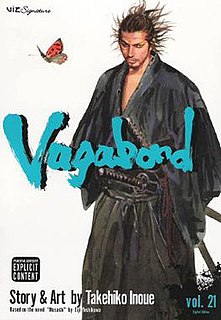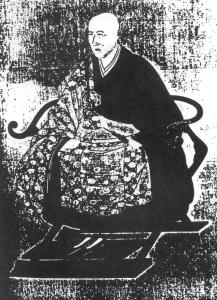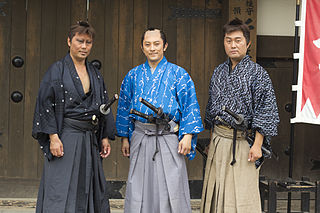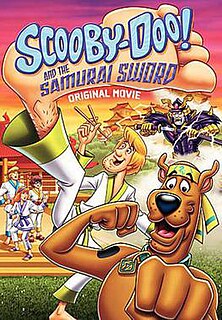
Vagabond is a Japanese epic martial arts seinen manga series written and illustrated by Takehiko Inoue. It portrays a fictionalized account of the life of Japanese swordsman Musashi Miyamoto, based on Eiji Yoshikawa's novel Musashi.

Yagyū Munenori was a Japanese swordsman, founder of the Edo branch of Yagyū Shinkage-ryū, which he learned from his father Yagyū "Sekishūsai" Muneyoshi. This was one of two official sword styles patronized by the Tokugawa shogunate. Munenori began his career in the Tokugawa administration as a hatamoto, a direct retainer of the Tokugawa house, and later had his income raised to 10,000 koku, making him a minor fudai daimyō, with landholdings around his ancestral village of Yagyū-zato. He also received the title of Tajima no Kami (但馬守).

Takuan Sōhō was a major figure in the Rinzai school of Zen Buddhism.

Lone Wolf and Cub is a manga created by writer Kazuo Koike and artist Goseki Kojima. First published in 1970, the story was adapted into six films starring Tomisaburo Wakayama, four plays, a television series starring Kinnosuke Yorozuya, and is widely recognized as an important and influential work.
Yagyū Jūbei Mitsuyoshi was one of the most famous and romanticized of the samurai in Japan's feudal era.

Jidaigeki is a genre of film, television, video game, and theatre in Japan. Literally meaning "period dramas", they are most often set during the Edo period of Japanese history, from 1603 to 1868. Some, however, are set much earlier—Portrait of Hell, for example, is set during the late Heian period—and the early Meiji era is also a popular setting. Jidaigeki show the lives of the samurai, farmers, craftsmen, and merchants of their time. Jidaigeki films are sometimes referred to as chambara movies, a word meaning "sword fight", though chambara is more accurately a subgenre of jidaigeki. Jidaigeki rely on an established set of dramatic conventions including the use of makeup, language, catchphrases, and plotlines.

Shintō Musō-ryū, or Shindō Musō-ryū (神道夢想流), most commonly known by its practice of jōdō, is a traditional school (koryū) of the Japanese martial art of jōjutsu, or the art of wielding the short staff (jō). The technical purpose of the art is to learn how to defeat a swordsman in combat using the jō, with an emphasis on proper combative distance, timing and concentration. The system includes teachings of other weapon systems which are contained in Shintō Musō-ryū as auxiliary arts. The school is sometimes abbreviated as SMR.
Yagyū Shinkage-ryū (柳生新陰流) is one of the oldest Japanese schools of swordsmanship (kenjutsu). Its primary founder was Kamiizumi Nobutsuna, who called the school Shinkage-ryū. In 1565, Nobutsuna bequeathed the school to his greatest student, Yagyū Munetoshi, who added his own name to the school. Today, the Yagyū Shinkage-ryū remains one of the most renowned schools of Japanese swordsmanship. Its name roughly means Yagyū New Shadow School.
Ninja Scroll: The Series is a 2003 Japanese animated television series based on Yoshiaki Kawajiri's Ninja Scroll. The series is directed by Tatsuo Sato and animated by Madhouse.

Yagyū Shingan-ryū (柳生心眼流), is a traditional school (koryū) of Japanese martial arts. Different styles of Yagyū Shingan-ryū, such as Heihojutsu and Taijutsu, assert different founders, Takenaga Hayato and Araki Mataemon respectively, but they all go back to Ushū Tatewaki, referred to in some historical scrolls as Shindō Tatewaki, who taught a system based on Sengoku-period battlefield tactics, that was called Shindō-ryū.
The Yagyū were a family of daimyōs with lands just outside Nara, who became the heads of one of Japan's greatest schools of swordsmanship, Yagyū Shinkage-ryū. The Yagyū were also Kenjutsu teachers to the Tokugawa shōguns and descendant of the famous Taira clan, hailing from prestigious Imperial Lineage with the Kabane rank of Ason.
Yagyū Sekishūsai Taira-no-Munetoshi was a samurai in Japan's Sengoku period famous for mastering the Shinkage-ryū school of combat, and introducing it to the Tokugawa clan. He was also known as Shinsuke, or Shinzaemon.
This is a list of fictional depictions of Miyamoto Musashi, the famous 17th-century Japanese swordsman.
Ittō-ryū (一刀流), meaning "one-sword school", is the ancestor school of several Japanese Koryū kenjutsu styles, including Ono-ha, Mizoguchi-ha, Nakanishi-ha, Kogen, Hokushin, and Itto Shoden. The style was developed by Ittōsai Kagehisa.
Takenaga Hayato 竹永 隼人(birth and death unknown) was the founder of the mainline Yagyū Shingan-ryū(柳生心眼流) a.k.a. Shingan ryu martial arts tradition circa 1600. The YAGYU SHINGAN ryu in its entirety is a school of Heiho jutsu.
Chris Bradford is an English author and black belt martial artist, best known for his children's fictional series, Young Samurai.
Young Samurai is a series of martial arts/action-adventure stories written by Chris Bradford, set in 17th century Japan, following the exploits of an English boy, Jack Fletcher, as he strives to be the first gaijin samurai.

Young Samurai: The Way of the Warrior is a children's historical novel by Chris Bradford, published in 2008. It is the first in a series of action-adventure stories set in 17th century Japan following the exploits of an English boy, Jack Fletcher, as he strives to be the first gaijin samurai.
Many significant Japanese historical people of the Sengoku period appear in works of popular culture such as anime, manga, and video games. This article presents information on references to several historical people in such works.

Scooby-Doo! and the Samurai Sword is a 2009 direct-to-DVD animated comedy mystery martial arts film, as well as the thirteenth entry in a series of direct-to-video animated films based upon the Scooby-Doo Saturday morning cartoon franchise. In the United States, the DVD sold 163,890 units in its first week and as of January 2014, it has sold approximately 524,725 units.









